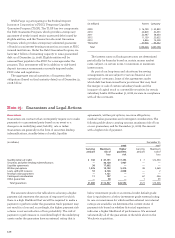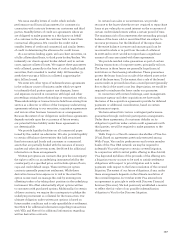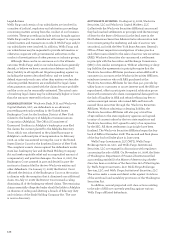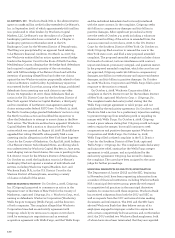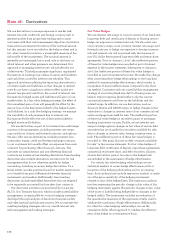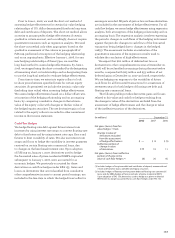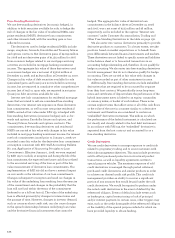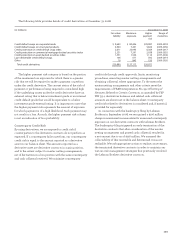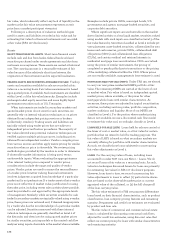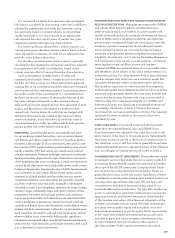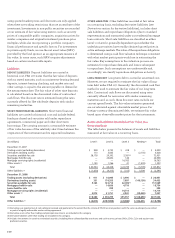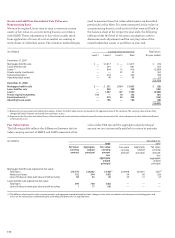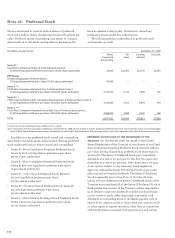Wells Fargo 2008 Annual Report Download - page 136
Download and view the complete annual report
Please find page 136 of the 2008 Wells Fargo annual report below. You can navigate through the pages in the report by either clicking on the pages listed below, or by using the keyword search tool below to find specific information within the annual report.
Free-Standing Derivatives
We use free-standing derivatives (economic hedges), in
addition to debt securities available for sale, to hedge the
risk of changes in the fair value of residential MSRs, new
prime residential MHFS, derivative loan commitments
and other interests held, with the resulting gain or loss
reflected in income.
The derivatives used to hedge residential MSRs include
swaps, swaptions, forwards, Eurodollar and Treasury futures
and options contracts. Net derivative gains of $3,099 million
for 2008 and net derivative gains of $1,154 million for 2007
from economic hedges related to our mortgage servicing
activities are included in mortgage banking noninterest
income. The aggregate fair value of these derivatives used
as economic hedges was a net asset of $3,610 million at
December 31, 2008, and $1,652 million at December 31, 2007.
Changes in fair value of debt securities available for sale
(unrealized gains and losses) are not included in servicing
income, but are reported in cumulative other comprehensive
income (net of tax) or, upon sale, are reported in net gains
(losses) on debt securities available for sale.
Interest rate lock commitments for residential mortgage
loans that we intend to sell are considered free-standing
derivatives. Our interest rate exposure on these derivative
loan commitments, as well as most new prime residential
MHFS carried at fair value under FAS 159, is hedged with
free-standing derivatives (economic hedges) such as for-
wards and options, Eurodollar futures and options, and
Treasury futures, forwards and options contracts. The
commitments, free-standing derivatives and residential
MHFS are carried at fair value with changes in fair value
included in mortgage banking noninterest income. For interest
rate lock commitments issued prior to January 1, 2008, we
recorded a zero fair value for the derivative loan commitment
at inception consistent with SEC Staff Accounting Bulletin
No. 105, Application of Accounting Principles to Loan
Commitments. Effective January 1, 2008, we were required
by SAB 109 to include, at inception and during the life of the
loan commitment, the expected net future cash flows related
to the associated servicing of the loan as part of the fair
value measurement of derivative loan commitments. The
implementation of SAB 109 did not have a material impact
on our results or the valuation of our loan commitments.
Changes subsequent to inception are based on changes in
fair value of the underlying loan resulting from the exercise
of the commitment and changes in the probability that the
loan will not fund within the terms of the commitment
(referred to as a fall-out factor). The value of the underlying
loan is affected primarily by changes in interest rates and
the passage of time. However, changes in investor demand,
such as concerns about credit risk, can also cause changes
in the spread relationships between underlying loan value
and the derivative financial instruments that cannot be
hedged. The aggregate fair value of derivative loan
commitments in the balance sheet at December 31, 2008
and 2007, was a net asset of $125 million and $6 million,
respectively, and is included in the caption “Interest rate
contracts” under Customer Accommodation, Trading and
Other Free-Standing Derivatives in the table on page 136.
We also enter into various derivatives primarily to provide
derivative products to customers. To a lesser extent, we take
positions based on market expectations or to benefit from
price differentials between financial instruments and markets.
These derivatives are not linked to specific assets and liabilities
in the balance sheet or to forecasted transactions in an
accounting hedge relationship and, therefore, do not qualify for
hedge accounting. We also enter into free-standing derivatives
for risk management that do not otherwise qualify for hedge
accounting. They are carried at fair value with changes in
fair value recorded as part of other noninterest income.
Additionally, free-standing derivatives include embedded
derivatives that are required to be accounted for separate
from their host contract. We periodically issue long-term
notes and certificates of deposit where the performance of the
hybrid instrument notes is linked to an equity, commodity
or currency index, or basket of such indices. These notes
contain explicit terms that affect some or all of the cash flows
or the value of the note in a manner similar to a derivative
instrument and therefore are considered to contain an
“embedded” derivative instrument. The indices on which
the performance of the hybrid instrument is calculated are
not clearly and closely related to the host debt instrument.
In accordance with FAS 133, the “embedded” derivative is
separated from the host contract and accounted for as a
free-standing derivative.
Credit Derivatives
We use credit derivatives to manage exposure to credit risk
related to proprietary trading and to assist customers with
their risk management objectives. This may include protection
sold to offset purchased protection in structured product
transactions, as well as liquidity agreements written to
special purpose vehicles. The maximum exposure of sold
credit derivatives is managed through posted collateral,
purchased credit derivatives and similar products in order
to achieve our desired credit risk profile. This credit risk
management provides an ability to recover a significant
portion of any amounts that would be paid under the sold
credit derivatives. We would be required to perform under
the noted credit derivatives in the event of default by the
referenced obligors. Events of default include events such
as bankruptcy, capital restructuring or lack of principal
and/or interest payment. In certain cases, other triggers may
exist, such as the credit downgrade of the referenced obligors
or the inability of the special purpose vehicle for which we
have provided liquidity to obtain funding.




